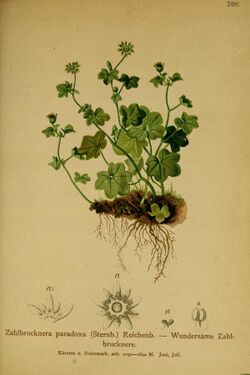Biology:Saxifraga paradoxa
| Saxifraga paradoxa | |
|---|---|

| |
| Scientific classification | |
| Kingdom: | Plantae |
| Clade: | Tracheophytes |
| Clade: | Angiosperms |
| Clade: | Eudicots |
| Order: | Saxifragales |
| Family: | Saxifragaceae |
| Genus: | Saxifraga |
| Species: | S. paradoxa
|
| Binomial name | |
| Saxifraga paradoxa Sternb.[1]
| |
| Synonyms[1] | |
| |
Saxifraga paradoxa, commonly known as the fragile saxifrage,[2] is a perennial plant species in the family Saxifragaceae,[3] which occurs as a tertiary relict and endemic Saxifraga species[4] in the South-Eastern Alps.[5] Count Kaspar Maria von Sternberg described this species in his work Revisio Saxifragarum iconibus of 1810.[3]
Description
This perennial species is a deciduous to semi-deciduous low-growing plant that can reach up to 20 cm (8 in) in height and can spread around for approximately 30 cm (12 in)[2] with its ascending to decumbent stems.[6] Its shining and small leaves are mid- to bright green, in shape usually reniform (kidney-like) and slightly lobed.[2][6] Saxifraga paradoxa characteristic are also small pale green coloured flowers that have linearly-shaped petals, red anthers and are arranged into an axillary cyme.[2][7] The plant's flowering period is between May and August.[8]
Distribution and conservation
This Saxifraga species native range are South-Eastern Alps, with most of its populations inhabiting Slovenia and Austria.[3] In Austria Saxifraga paradoxa occurs in Carinthia and Styria,[7] while in Slovenia its growing area includes valleys of rivers Hudinja[9] and Lobnica (tributary of Drava)[10] near Pohorje, as well as Kozjak mountains and Košenjak.[7] Its habitat usually consists of damp and shaded rocky screes with non-calcareous basis, mostly containing granite and gneiss.[6][11] After this species Slovakian botanist Ladislav Mucina named plant community Saxifragetum paradoxae, with Saxifraga paradoxa being its characteristic species.[4]
Saxifraga paradoxa has not yet been evaluated for the IUCN Red List.[12]
Taxonomy
So-called European purple saxifrages (members of Saxifraga's section Porphyrion and subsection Oppositifoliae) are a big group of numerous taxa with uncertain taxonomic position, widely distributed in mountain ranges of central and southern Europe. Researchers studied their evolutionary relationship with a use of amplified fragment length polymorphism (AFLP) fingerprinting and Saxifraga paradoxa was shown not to be genetically divergent taxon.[13] Recent research treats Saxifraga paradoxa as a member of Saxifraga's section Saxifraga and subsection Arachnoideae.[14][15]
References
- ↑ 1.0 1.1 "Saxifraga paradoxa Sternb.". http://worldfloraonline.org/taxon/wfo-0000493621;jsessionid=8D18BDF1497C1036470E0A120F11ECC0.
- ↑ 2.0 2.1 2.2 2.3 "Saxifraga paradoxa Fragile saxifrage Zahlbrucknera Care Plant Varieties & Pruning Advice" (in en). http://www.shootgardening.co.uk/plant/saxifraga-paradoxa.
- ↑ 3.0 3.1 3.2 "Saxifraga paradoxa Sternb." (in en). https://www.gbif.org/species/3753560.
- ↑ 4.0 4.1 Juvan, Nina (2008). "Vegetacija skalnih razpok silikatnega skalovja : diplomska naloga". https://repozitorij.uni-lj.si/IzpisGradiva.php?id=123044.
- ↑ "Saxifraga paradoxa Sternb. | Plants of the World Online | Kew Science" (in en). http://powo.science.kew.org/taxon/urn:lsid:ipni.org:names:794233-1.
- ↑ 6.0 6.1 6.2 "Saxifraga paradoxa" (in en). https://www.alpinegardensociety.net/.
- ↑ 7.0 7.1 7.2 Praprotnik, Dr Nada. "Deloindom - Kamnokreči: Prvaki rastlinskega sveta" (in sl). https://deloindom.delo.si/trajnice/kamnokreci-prvaki-rastlinskega-sveta.
- ↑ "Pregled organizmov-Nenavadni kamnokreč". http://www.fito-info.si/APL/Sist/takson.asp?CODE=401DB0EC-519B-4CB5-A587-6A2CB6551718.
- ↑ "Vitanje – Gremoven.com" (in en-US). https://www.gremoven.com/vitanje/.
- ↑ "Lobnica na Pohorju" (in sl-SI). https://www.gore-ljudje.si/lobnica-na-pohorju.
- ↑ "Endemische Pflanzen der Ostalpen - Veranstaltung | Naturkundemuseum" (in de). https://www.museum-joanneum.at/naturkundemuseum/ihr-besuch/programm/botanik-mykologie/events/event/1426/endemische-pflanzen-der-ostalpen.
- ↑ "Saxifraga paradoxa - Sternb.". https://eunis.eea.europa.eu/species/Saxifraga%20paradoxa.
- ↑ Winkler, Manuela; Tribsch, Andreas; Schneeweiss, Gerald M.; Brodbeck, Sabine; Gugerli, Felix; Holderegger, Rolf; Schönswetter, Peter (2013-10-29). "Strong nuclear differentiation contrasts with widespread sharing of plastid DNA haplotypes across taxa in European purple saxifrages (SaxifragasectionPorphyrionsubsectionOppositifoliae)". Botanical Journal of the Linnean Society 173 (4): 622–636. doi:10.1111/boj.12104. ISSN 0024-4074.
- ↑ Gerschwitz, Michael; Kadereit, Joachim W. (2020). "Species composition of Saxifraga sect. Saxifraga subsect. Arachnoideae (Saxifragaceae) based on DNA sequence evidence" (in en). Willdenowia 50 (2): 225. doi:10.3372/wi.50.50208. ISSN 1868-6397. https://pubag.nal.usda.gov/catalog/6973425.
- ↑ Tkach, Natalia; Röser, Martin; Suchan, Tomasz; Cieślak, Elżbieta; Schönswetter, Peter; Ronikier, Michał (2019-01-11). "Contrasting evolutionary origins of two mountain endemics: Saxifraga wahlenbergii (Western Carpathians) and S. styriaca (Eastern Alps)". BMC Evolutionary Biology 19 (1): 18. doi:10.1186/s12862-019-1355-x. ISSN 1471-2148. PMID 30634910.
External links
Wikidata ☰ Q15608615 entry
 |

